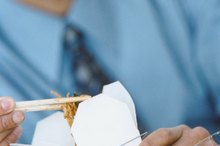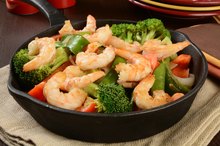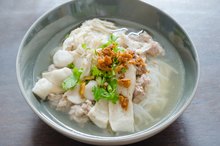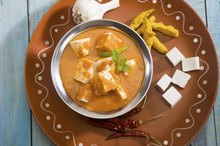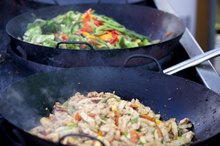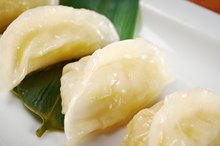What does fact checked mean?
At Healthfully, we strive to deliver objective content that is accurate and up-to-date. Our team periodically reviews articles in order to ensure content quality. The sources cited below consist of evidence from peer-reviewed journals, prominent medical organizations, academic associations, and government data.
The information contained on this site is for informational purposes only, and should not be used as a substitute for the advice of a professional health care provider. Please check with the appropriate physician regarding health questions and concerns. Although we strive to deliver accurate and up-to-date information, no guarantee to that effect is made.
Chinese Food Nutrition Values
A trip to a Chinese restaurant offers many ways to go right in your efforts to maintain a healthful diet--and many ways to go wrong. Careful choices can lead to a nutritious, guilt-free dining experience. The nutritional negatives that you will find with standard Chinese fare are not quite the same as those of typical Western dishes, but they are important nonetheless.
Benefits
The upside to Chinese food is it tends to be low in saturated fat and trans fat, which, according to the American Heart Association, raises blood cholesterol 2. High blood cholesterol, according to the group, is linked to heart disease. The reason for the low fat levels is that Chinese dishes rely on vegetable oil, forgo cheese and tend to contain seafood, poultry and vegetables.
- The upside to Chinese food is it tends to be low in saturated fat and trans fat, which, according to the American Heart Association, raises blood cholesterol 2.
Disadvantages
Low Calorie Chinese Foods
Learn More
The main nutritional problem with Chinese food is that it is often high in sodium and it tends to be packed with calories, according to the Center for Science in the Public Interest 1. The calorie-adding culprits are oil, noodles, sauces and deep-friend breading.
Examples
Among the worst offenders on the typical Chinese restaurant menu is General Tso's chicken. It is "essentially fried chicken with a smattering of vegetables," according to the Center for Science in the Public Interest 1. A typical dinner-sized portion has 1,300 calories and 3,200mg of sodium. Orange beef contains 1,500 calories and 3,100mg of sodium. Fried rice provides you with 1,500 calories and 2,700mg.
- Among the worst offenders on the typical Chinese restaurant menu is General Tso's chicken.
- Orange beef contains 1,500 calories and 3,100mg of sodium.
Effects
Chinese Take Out Calories
Learn More
The excess calories of Chinese food can contribute to weight gain if you eat it cuisine often. The average person needs only 2,000 calories per day, though requirements vary. Obesity can lead to harmful health effects such as high blood pressure, diabetes, heart disease and cancer, according to Stanford Hospital and Clinics. The American Heart Association recommends limiting sodium to 1,500mg per day, so a single meal of Chinese food can easily contain two days' worth of sodium 2. High-sodium diets can lead to high blood pressure, according to the association, and to increased risk of heart disease and stroke.
- The excess calories of Chinese food can contribute to weight gain if you eat it cuisine often.
- High-sodium diets can lead to high blood pressure, according to the association, and to increased risk of heart disease and stroke.
Tips
When eating Chinese food, avoid deep-fried items and instead choose chicken, seafood or tofu items that are lightly stir-fried, according to the Committee for Science in the Public Interest 1. Even better, choose dishes that focus on vegetables, not meat. Avoid adding duck sauce, which contains 100mg per tbsp.; hoisin sauce, which contains 250mg per tbsp.; and especially soy cause, which has 1,000mg per tbsp.
- When eating Chinese food, avoid deep-fried items and instead choose chicken, seafood or tofu items that are lightly stir-fried, according to the Committee for Science in the Public Interest 1.
- Avoid adding duck sauce, which contains 100mg per tbsp.
- ;
Related Articles
References
- Center for Science in the Public Interest: Chinese Restaurant Food
- American Heart Association: Saturated Fats
- U.S. Department of Agriculture: Dietary Guidelines for Americans
- Felix A, Tuano APP, Mallillin A, Trinidad T, Juliano BO. Short-term satiety of brown rice and milled rice. Phillipine J Crop Sci. 2016;41(1):52-59.
- Restaurant, Chinese, chicken chow mein. FoodData Central. U.S. Department of Agriculture. Published April 1, 2019.
- Chicken chow mein. FoodData Central. U.S. Department of Agriculture. Published April 1, 2019.
- Egg roll, with shrimp. FoodData Central. U.S. Department of Agriculture. Published April 1, 2019.
- Roll with meat and/or shrimp, vegetables and rice paper (not fried). FoodData Central. U.S. Department of Agriculture. Published April 1, 2019.
Resources
Writer Bio
Ranlyn Oakes is a business writer and journalist with more than a decade as either a staff writer or freelancer for a variety of regional and national publications, including newspapers and magazines. His specialties include health care, international trade, manufacturing and career advice. Oakes holds a Bachelor of Arts in print journalism from the University of Kentucky.

